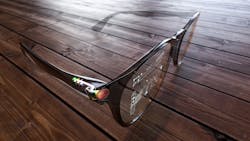Augmented reality (AR), virtual reality (VR), extended reality (XR), and mixed reality (MR) have rapidly become buzzwords, leading to a lot of experimentation and excitement about future applications. While the technologies are often lumped together, it is important to note the clear distinctions in underlying technologies and use cases. Of the group, AR has the most realistic potential within the near future.
According to Eric Abbruzzese, research director with ABI Research (New York, NY), AR is best defined as any device with a screen that enables pass-through or glanceable digital content, which includes both mobile devices and smart glasses, and within smart glasses this includes mixed reality devices like Microsoft HoloLens and assisted reality devices like RealWear.
When considering AR, the enterprise market started stronger with worker enablement and high value use cases like remote assistance, training, and data capture (for example, real-time capture of audio, images, video, machine/environment data). “This has been true for both smart glasses and mobile devices, with mobile being the dominant device used for AR thanks to cost and ease of integration compared to glasses,” says Abbruzzese. “The smart glasses hardware market is getting more competitive, though, so falling prices and generally greater knowledge and comfort around smart glasses (in both consumer and enterprise spaces) will help spur adoption.”
Laser-driven evolution
Evolutions from within the photonics community are surfacing as key components as AR technology moves from trendy prototypes to mass production products. Consider, for instance, the potential when using laser beam scanning (LBS). LBS shows considerable advantages over other technologies (such as LCOS, DLP, LCD, and OLED) with respect to achievable form factor (size), power consumption, weight, brightness, and contrast.
Additionally, LBS only generates light and consumes power where information is needed. And, since earliest generations of AR smart glasses products mainly show icons and messages, LBS far outshines power-hungry spatial light modulator-based systems. As such, LBS is the key to enabling stylish smart glasses for real consumer AR products (see Fig. 1).
“LBS beats the µLED-based approaches in part because µLED is not capable of demonstrating a mass production-compatible manufacturing process that comes along with a suitably high yield,” says Dr. Ulrich Hofmann, founder and managing director of OQmented (Itzehoe, Germany). OQmented is a deep tech company developing and selling high-performance MEMS mirrors for ultracompact LBS displays and best-in-class 3D sensing solutions for mobile and stationary applications (see Fig. 2). In addition, the µLED concept seems to be more inefficient and power-hungry, so the smaller the pixels get—which seems to limit achievable resolution.The expectation is that the first AR smart glasses using LBS will be based on combinations with diffractive waveguides because the “concept is convincing with respect to large eyebox (the range of how far the eyes can be moved without cropping the image). However, the LBS concept could still be more power-efficient if LBS was to be combined with holographic combiners. Such an approach could help reduce power consumption of the laser sources by more than one order of magnitude,” says Hofmann. “However, so far, the eyebox of that approach is much too small, and as such needs to be solved, first. If the eyebox problem of the holographic combiner approach is not solved, there will probably be only waveguide-based AR LBS products.”
Hofmann tells Laser Focus World there is room for improvements when it comes to integration technologies and packaging. “Besides the well-established and more conventional solutions of combining multi-component RGB laser modules with our MEMS mirrors to build a complete light engine of first product generations of AR smart glasses, we also develop technologies that allow for a higher integration level and improved and more efficient mass production throughput,” he says (see Fig. 3). “To minimize the system size, we consequently integrate both scanning axes of the MEMS mirror on a single chip in contrast to other approaches where two single-axis scanning mirror chips are being used and need to be accurately aligned.”Since power consumption and long operation time plays such an important role, OQmented is operating both scanning axes in resonance—yielding the most power-efficient mode of a mechanical spring mass system while also allowing for largest oscillation amplitudes and optical resolution. “We also encapsulated the whole MEMS mirror in a miniature vacuum capsule, which effectively reduces damping (friction) losses,” says Hofmann. “That further increases the achievable oscillation amplitudes and optical resolution, and leads to even lower power consumption. This way, the MEMS mirror and MEMS driver can be designed to consume less than 10 mW.”
Future is nearing
Instead of focusing on the professional AR market, where size and power consumption are irrelevant, OQmented is targeting fashionable consumer AR smart glasses (see video). “This technology is a key enabler for real AR consumer products, and in the long run it will be the enabler to replace the smartphone by AR smart glasses,” Hofmann says. “For many years, we have seen bulky, ugly AR/VR helmets, but besides the gamers and professionals, this technology was not commonly accepted.”
Hofmann expects widespread acceptance will come when the AR concept allows a comfortable, stylish, all-day-long wearable device, even with initial shortcomings and limitations with respect to resolution and performance. “Trying it the other way around and coming from high-performance criteria and sacrificing form factor, shape, and appearance has definitely failed,” he says. “Some AR/VR companies that were using and pushing spatial light modulator-based approaches in the past could have already changed towards LBS for certain products.”
According to ABI Research, the consumer inflection point in consumer smart glasses shipments is closer than some may think—specifically 2023. “As soon as Apple releases its mass-market AR smart glasses device, the market will take off. Some players will come before—nReal has been a notable early player, and Meta’s real AR device with a display (as opposed to Ray-Ban Stories, which are not visual-capable) is expected in the next year—but Apple has the iOS install base, brand power, and AR/VR service and content foundation to hit the ground running,” says Abbruzzese.
ABI Research’s numbers paint a pretty picture for AR, with total smart glasses shipments projected to have a 66% CAGR through 2026 to make up almost 28 million shipments—this is across all verticals, and both consumer and enterprise. Additionally, some consumer verticals are growing most quickly, like media/entertainment at over 100% CAGR. While gaming still dominates for VR, retail is a promising vertical for early consumer AR activity, and ABI has seen the potential of that with numerous AR retail integrations for virtual try-on, cosmetics, furniture, and more. “Apple’s ongoing Shopify integration is another example of them being ready for an AR swell,” says Abbruzzese.
External forces
Outside of the hype (fueled mostly by the Meta/Facebook rebranding efforts), there’s still so much to materialize around metaverse. “What are the high-value use cases short-term, how data handoff between platforms is handled (something absolutely critical to the metaverse and yet not really discussed yet), what hardware and infrastructure is required,” says Abbruzzese. “It’s still very early for metaverse so there is time for maturation here, but no matter how it plays out, both AR and VR fill a critical role in immersive content consumption.”
5G is important to mention as well, not so much as a requirement for AR or VR today, but instead a value-add and a means of broadening capability going forward. “As standalone HMDs (both AR and VR) make up the majority of their respective markets, there’s great interest in offloading processing where possible to improve battery life and form factor,” says Abbruzzese.
“Edge compute and streaming can allow for that, with anything from hybrid local/cloud to full cloud streaming,” says Abbruzzese. “Most flagship smartphones today support 5G, and so any AR/VR usage with a smartphone base at least has the connectivity radios needed. Relatedly, most smartphones also support AR at the OS level (Apple ARKit and Google ARCore), and so mobile device AR remains a compelling AR choice for many.”

Peter Fretty | Market Leader, Digital Infrastructure
Peter Fretty began his role as the Market Leader, Digital Infrastructure in September 2024. He also serves as Group Editorial Director for Laser Focus World and Vision Systems Design, and previously served as Editor in Chief of Laser Focus World from October 2021 to June 2023. Prior to that, he was Technology Editor for IndustryWeek for two years.
As a highly experienced journalist, he has regularly covered advances in manufacturing, information technology, and software. He has written thousands of feature articles, cover stories, and white papers for an assortment of trade journals, business publications, and consumer magazines.


